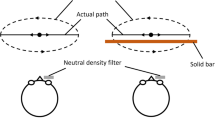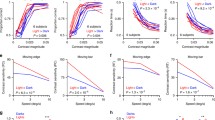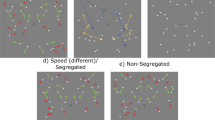Abstract
Humans do not confound the motion of shadows cast upon a surface with the motion of the surface itself, although schemes that propose recombination of orientation-selective motion signals into a rigid motion percept of two-dimensional patterns would predict that they should do so. We propose a simple scheme that avoids recombination and instead attributes perception of two-dimensional pattern motion to the activation of orientation-selective end-stopped units that operate on the logarithm of the luminance. The proposed units respond to the change of contrast along a line, which typically occurs at an intersection. They are not active, however, when a shadow border intersects the edge of an object, because contrast does not change along either of these edges. Thus, end-stopped units signal the motion of transparent intersections weakly or not at all, and the independent motions of the shadow border and the object prevail. We tested two implications of this scheme, using plaids with variable intersection luminance. First, when the intersection luminance was such that it kept the contrast along the intersecting lines nearly constant, the sensitivity for the rigid plaid's direction of motion was minimal, and the sliding motion of the components prevailed. This occurred for light bars on dark backgrounds and for dark bars on light backgrounds. Thus, the effect of the intersection's luminance on the balance between the percepts of rigid-plaid motion and the motion of sliding components was independent of contrast inversion of bar and background. Secondly, when thin lines with the same luminance as the bars covered the borders of the intersection, the intersection's luminance did not affect the rigid-plaid motion percept very much, even when it corresponded to a transparent intersection. This indicates that, when the edges of the intersection and those of the bars were not collinear, the nulling of the endstopped units did not occur. This result is in line with physiological studies, which showed that the response of an end-stopped cell to a line is only partially inhibited when a similar line is presented non-collinearly with the first in the inhibitory end-zone of its receptive field. Our results are consistent with a scheme in which a second stage of motion detectors combines signals of orientation-selective end-free and orientation-selective end-stopped units for perception of the rigid motion of two-dimensional patterns.
Similar content being viewed by others
References
Adelson EH, Movshon JA (1982) Phenomenal coherence of moving visual patterns. Nature 300:523–525
Adelson EH, Movshon JA (1984) Binocular disparity and the computation of two-dimensional motion. J Opt Soc Am [A] 1:1266
Albright TD (1991) Color and the integration of motion signals. Trends Neurosci 14:266–269
Berg AV van den, Grind WA van de (1991) Conditions for the detection of coherent motion. Vision Res 31:1039–1051
Berg AV van den, Grind WA van de (1993) Do component motions recombine into a moving plaid percept? Exp Brain Res 93:312–323
Berg AV van den, Grind WA van de, Doorn JA van (1990) Motion detection in the presence of local orientation changes. J Opt Soc Am [A] 5:933–939
DeValois RL, DeValois K (1990) Stationary moving gabor plaids. Invest Ophthalmol Vis Sci [Suppl] 31:171
Doorn AJ van, Koenderink JJ (1982a) Spatial properties of the visual detectability of moving spatial white noise. Exp Brain Res 45:189–195
Doorn AJ van, Koenderink JJ (1982b) Temporal properties of the visual detectability of moving spatial white noise. Exp Brain Res 45:179–188
Ferrera KP, Wilson HR (1987) Direction specific masking and the analysis of motion in two dimensions. Vision Res 27:1783–1796
Grind WA van de, Koenderink JJ, Doorn JA van (1992) Viewingdistance invariance of movement detection. Exp Brain Res 91:135–150
Hubel DH, Wiesel TN (1965) Receptive fields and functional architecture in two nonstriate visual areas (18 and 19) of the cat. J Neurophysiol 28:229–289
Heitger F, Rosenthaler L, Von der Heydt R, Peterhans E, Kubler O (1992) Simulation of neural contour mechanisms: from simple to end-stopped cells. Vision Res 32:963–981
Koenderink JJ, Doorn JA van (1987) Representation of local geometry in the visual system. Biol Cybern 55:367–375
Koenderink JJ, Doorn JA van, Grind WA van de (1988) Motion detection at low luminances. Perception [Suppl] 17:350 (A12)
Lorenceau J, Shiffrar M (1992) The influence of terminators on motion integration across space. Vision Res 32:263–273
Marshak W, Sekuler R (1979) Mutual repulsion between moving visual targets. Science 205:1399–1401
Mingolla E, Todd JT, Norman F (1992) The perception of globally coherent motion. Vision Res 32:1015–1031
Morgan MJ, Fahle M (1992) Effects of pattern element density upon displacement limits for motion detection in random binary luminance patterns. Proc R Soc Lond [Biol] 248:189–198
Nakayama K (1985) Biological image motion processing: a review. Vision Res 25:625–660
Newsome WT, Britten KH, Movshon JA (1989) Neuronal correlates of a perceptual decision. Nature 341:52–54
Noest A, Berg AV van den (1993) The role of early mechanisms in motion transparency and coherence. Spatial Vision 7:125–147
Peterhans E, Von der Heydt R (1989) Mechanisms of contour perception in monkey visual cortex. II. Contours bridging gaps. J Neurosci 9:1749–1763
Orban GA (1984) Neuronal operations in the visual cortex. Springer, Berlin Heidelberg New York
Orban GA, Kato H, Bishop PO (1979) Dimensions and properties of end-zone inhibitory areas in receptive fields of hypercomplex cells in cat striate cortex. J Neurophysiol 42:833–850
Sclar G, Lennie P, De Priest DD (1989) Contrast adaptation in striate cortex of macaque. Vision Res 29:747–755
Smith AT (1992) Coherence of plaids comprising components of disparate spatial frequencies. Vision Res 32:393–397
Simpson WA, Swanston MT (1991) Depth-coded motion signals in plaid perception and optokinetic nystagmus. Exp Brain Res 86:447–450
Stoner GR, Albright TD (1992) Neural correlates of perceptual motion coherence. Nature 358:412–414
Stoner Gr, Albright TD, Ramachandran VS (1990) Transparency and coherency in human motion perception. Nature 344:153–155
Tanaka K, Ohzawa I, Ramoa AS, Freeman RD (1987) Receptive field properties of cells in area 19 of the cat. Exp Brain Res 65:549–558
Vallortigara G, Bressan P (1991) Occlusion and the perception of coherent motion. Vision Res 31:1967–1978
Van Santen JPH, Sperling G (1984) Temporal covariance model of human motion perception. J Opt Soc Am [A] 1:451–473
Von der Heydt R, Peterhans E (1989) Mechanisms of contour perception in monkey visual cortex. I. Lines of pattern discontinuity. J Neurosci 9:1731–1748
Watson AB, Nielsen KK, Poirson A, Fitzhugh A, Bilson A, Nguyen K, Ahumada AJ (1986) Use of a raster frame buffer in vision research. Behav Res Methods Instrum Comput 18:587–594
Wilson HR, Ferrera VP, Yo C (1992) A psychophysically motivated model for two-dimensional motion perception. Visual Neurosci 9:79–97
Author information
Authors and Affiliations
Rights and permissions
About this article
Cite this article
van den Berg, A.V., Noest, A.J. Motion transparency and coherence in plaids: the role of end-stopped cells. Exp Brain Res 96, 519–533 (1993). https://doi.org/10.1007/BF00234120
Received:
Accepted:
Issue Date:
DOI: https://doi.org/10.1007/BF00234120




